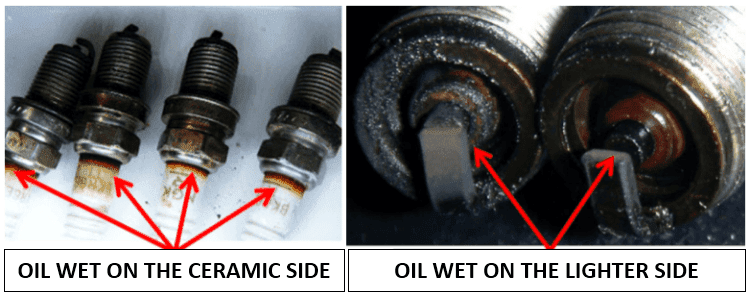The causes of car spark plugs wet with oil
As an important component in the car ignition system, the spark plug is the only component that responsible for burning the air and fuel mixture inside the engine chamber mostly for gasoline-fueled car engines.
Without a spark plug, the air-fuel mixture would not be flammable, could not explode, and could not generate engine power. Hence, the spark plug condition is critical, so it is necessary to regularly check and replace it.
But sometimes when we change spark plugs, the spark plugs look wet with engine oil. There are spark plugs that are wet with engine oil on the outside of the spark plug body (the ceramic part), and also there are spark plugs that are wet with oil at the tip of the lighter.
The condition of the oil-wet car spark plug will cause many things related to engine performance during engine run such as,
- The engine halts and shakes while idling.
- The engine feels shaking when accelerates.
- White smoke will appear due to burning oil from the exhaust pipe.
- If the oil-wet car spark plug is too bad, it will cause the spark plug to fall quickly.
As it is well known that when the spark plug is attached to the engine, the tip of the lighter will enter the engine combustion chamber, while the ceramic side will remain outside of the combustion chamber. Well, this time we will explain the causes of oil-wet spark plugs in these two conditions.
1. Oil-wet spark plug on the ceramic side
For oil-wet spark plugs on the ceramic side is usually caused by the rubber seal for the spark plug hole that has become hard and cannot close perfectly (some people called as spark plugs gasket or sparkplug seal).
In some engines, the spark plugs are installed right in the middle of the combustion chamber. This construction causes a hole in the middle of the engine head cylinder cover, specifically installing and removing the spark plugs.
Usually, a rubber seal is attached to the top of the holes in the cylinder head cover. Its use to prevent engine oil from entering the spark plug holes. When the rubber seal starts to become hard and cannot close perfectly, the engine oil will easily enter the spark plug hole, which can cause the spark plug to get wet. Pay attention to the image below ...
The solution to solve oil-wet spark plugs like this is to replace the entire spark plug rubber seal in each cylinder head cover. When the spark plug hole cover rubber works perfectly, the oil-wet spark plug on the ceramic side can be resolved.
2. Oil-wet spark plug on the tip of lighter
If the oil-wet spark plug is in the tip of a lighter part, it indicates that is so many oil leaks from the engine cylinder enter the combustion chamber. Here are some causes of oil-wet spark plugs in the tip of a lighter part.
A. Worn-out valve stem seal
To prevent engine oil from entering the combustion chamber, rubber seals are attached to the valve stem for the exhaust and intake valves. Over time, this rubber seal can harden and cannot close tightly anymore. The effect, engine oil can enter the combustion chamber and soak the spark plug head through the valve rod.
B. Worn-out piston rings and engine block cylinder walls
Apart from faulty valve stem seal, the next cause of oil-wet spark plugs is from worn-out piston rings and engine block cylinder walls.
The wear on the engine block's piston rings and cylinder walls will cause the engine oil not to be cleaned properly to be discharged back into the oil pan (engine oil reservoir). This condition will leave the oil on the engine cylinder wall.
The oil attached to this engine's cylinder walls will be compressed and mix with the air-fuel mixture. The oil layer in the combustion chamber will gradually increase and simultaneously wet the surface of the spark plug head. As a result, the spark plug head is wet with oil.
Also read:C. Engine oil is seeping from the cylinder head gasket
The next thing that can cause the spark plug to get wet is when the cylinder head gasket leaks oil, so that engine oil enters the combustion chamber.
Generally, this happens because the engine has experienced an overheat which causes the cylinder-head to curve, especially in the engine oil flow path.

